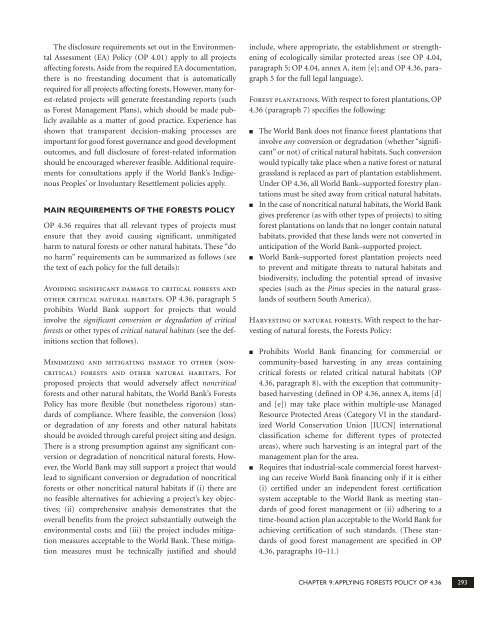Forests Sourcebook - HCV Resource Network
Forests Sourcebook - HCV Resource Network
Forests Sourcebook - HCV Resource Network
You also want an ePaper? Increase the reach of your titles
YUMPU automatically turns print PDFs into web optimized ePapers that Google loves.
The disclosure requirements set out in the Environmental<br />
Assessment (EA) Policy (OP 4.01) apply to all projects<br />
affecting forests. Aside from the required EA documentation,<br />
there is no freestanding document that is automatically<br />
required for all projects affecting forests. However, many forest-related<br />
projects will generate freestanding reports (such<br />
as Forest Management Plans), which should be made publicly<br />
available as a matter of good practice. Experience has<br />
shown that transparent decision-making processes are<br />
important for good forest governance and good development<br />
outcomes, and full disclosure of forest-related information<br />
should be encouraged wherever feasible. Additional requirements<br />
for consultations apply if the World Bank’s Indigenous<br />
Peoples’ or Involuntary Resettlement policies apply.<br />
MAIN REQUIREMENTS OF THE FORESTS POLICY<br />
OP 4.36 requires that all relevant types of projects must<br />
ensure that they avoid causing significant, unmitigated<br />
harm to natural forests or other natural habitats. These “do<br />
no harm” requirements can be summarized as follows (see<br />
the text of each policy for the full details):<br />
Avoiding significant damage to critical forests and<br />
other critical natural habitats. OP 4.36, paragraph 5<br />
prohibits World Bank support for projects that would<br />
involve the significant conversion or degradation of critical<br />
forests or other types of critical natural habitats (see the definitions<br />
section that follows).<br />
Minimizing and mitigating damage to other (noncritical)<br />
forests and other natural habitats. For<br />
proposed projects that would adversely affect noncritical<br />
forests and other natural habitats, the World Bank’s <strong>Forests</strong><br />
Policy has more flexible (but nonetheless rigorous) standards<br />
of compliance. Where feasible, the conversion (loss)<br />
or degradation of any forests and other natural habitats<br />
should be avoided through careful project siting and design.<br />
There is a strong presumption against any significant conversion<br />
or degradation of noncritical natural forests. However,<br />
the World Bank may still support a project that would<br />
lead to significant conversion or degradation of noncritical<br />
forests or other noncritical natural habitats if (i) there are<br />
no feasible alternatives for achieving a project’s key objectives;<br />
(ii) comprehensive analysis demonstrates that the<br />
overall benefits from the project substantially outweigh the<br />
environmental costs; and (iii) the project includes mitigation<br />
measures acceptable to the World Bank. These mitigation<br />
measures must be technically justified and should<br />
include, where appropriate, the establishment or strengthening<br />
of ecologically similar protected areas (see OP 4.04,<br />
paragraph 5; OP 4.04, annex A, item [e]; and OP 4.36, paragraph<br />
5 for the full legal language).<br />
Forest plantations. With respect to forest plantations, OP<br />
4.36 (paragraph 7) specifies the following:<br />
■<br />
■<br />
■<br />
The World Bank does not finance forest plantations that<br />
involve any conversion or degradation (whether “significant”<br />
or not) of critical natural habitats. Such conversion<br />
would typically take place when a native forest or natural<br />
grassland is replaced as part of plantation establishment.<br />
Under OP 4.36, all World Bank–supported forestry plantations<br />
must be sited away from critical natural habitats.<br />
In the case of noncritical natural habitats, the World Bank<br />
gives preference (as with other types of projects) to siting<br />
forest plantations on lands that no longer contain natural<br />
habitats, provided that these lands were not converted in<br />
anticipation of the World Bank–supported project.<br />
World Bank–supported forest plantation projects need<br />
to prevent and mitigate threats to natural habitats and<br />
biodiversity, including the potential spread of invasive<br />
species (such as the Pinus species in the natural grasslands<br />
of southern South America).<br />
Harvesting of natural forests. With respect to the harvesting<br />
of natural forests, the <strong>Forests</strong> Policy:<br />
■<br />
■<br />
Prohibits World Bank financing for commercial or<br />
community-based harvesting in any areas containing<br />
critical forests or related critical natural habitats (OP<br />
4.36, paragraph 8), with the exception that communitybased<br />
harvesting (defined in OP 4.36, annex A, items [d]<br />
and [e]) may take place within multiple-use Managed<br />
<strong>Resource</strong> Protected Areas (Category VI in the standardized<br />
World Conservation Union [IUCN] international<br />
classification scheme for different types of protected<br />
areas), where such harvesting is an integral part of the<br />
management plan for the area.<br />
Requires that industrial-scale commercial forest harvesting<br />
can receive World Bank financing only if it is either<br />
(i) certified under an independent forest certification<br />
system acceptable to the World Bank as meeting standards<br />
of good forest management or (ii) adhering to a<br />
time-bound action plan acceptable to the World Bank for<br />
achieving certification of such standards. (These standards<br />
of good forest management are specified in OP<br />
4.36, paragraphs 10–11.)<br />
CHAPTER 9:APPLYING FORESTS POLICY OP 4.36 293

















